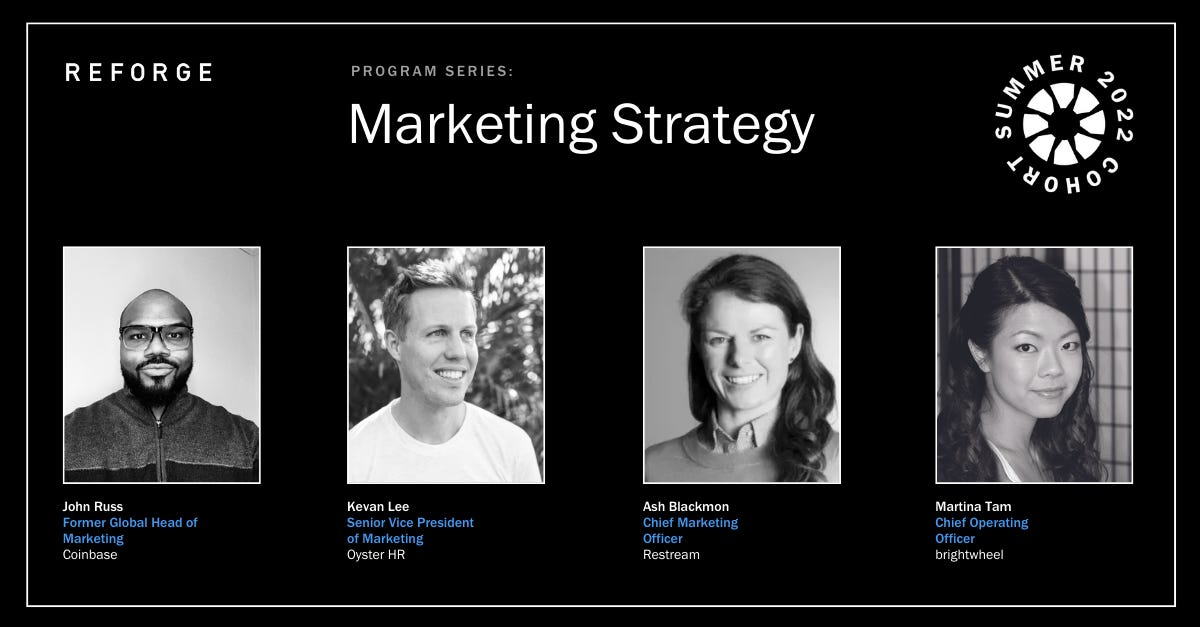332. Advising for beginners (like me) 🥷
A crash course in getting started as a marketing advisor
Hi there 👋
Long-time readers of this newsletter will know how much appreciation I have for Reforge and their marketing programs, which have been integral to my development as a marketer. I wouldn’t be where I am today without them.
They have two new marketing programs coming this fall: marketing leadership and brand marketing. I can highly, highly recommend both! I’ve helped a bit with the content for these courses and was a featured guest on their most recent marketing program. You can apply through the link above, and if you have any questions about how the programs work or my experience with Reforge, please do ask!
Wishing you a great week ahead,
Kevan
(ᵔᴥᵔ)
Thank you for being part of this newsletter. Each week, I share playbooks, case studies, stories, and links from inside the startup marketing world and my time at Oyster, Buffer, and more.
Say hi anytime at hello@kevanlee.com. I’d love to hear from you.
How to get started with advising
A few years ago, I casually added the word “advisor” to my Twitter bio, which led to a wonderful little SaaS company reaching out, asking great questions, and helping me realize I had no idea what advising truly meant.
A sample of their questions:
What is your specialty?
How much do you charge?
What does a typical engagement look like?
These seem like simple questions, but I was totally unprepared for how specific and tangible they were. If advising is a spectrum, I was on the extreme end of having one-off, casual chats with companies. I was the most novice of beginners.
I’ve come a bit further since, and I’ll share a few of my tips and learnings below.
If you’re doing part-time advising or full-time advising, I’d love any advice you’ve learned along the way, too! Feel free to reply to this newsletter or message me at hello@kevanlee.com.
1. Taking the first steps
How do you know if you will even like advising? As you can probably guess, advising is very different than being an in-house marketer and full-time operator. You are working with less context, smaller timeframes, fewer connections, and more pattern matching. It’s a whole new world, and it’s not for everyone.
But you never know until you try. :)
Start small.
For me, starting small meant saying yes to introductions and opportunities no matter how tiny. These weren’t even official advising roles; they were more like meet-n-greets to hear about the puzzles that a company was solving and what kind of help they needed. I thought of it like next-level networking where you’re meeting people (Goal #1) and getting a feel for what it might be like to work on their challenges (Goal #2).
When I was thinking of what’s next after my Buffer role, I started taking these first steps to see what advising might feel like. I met with the CEO of Calendly to talk about content marketing. I met with the team at Milanote to discuss Product-Led Growth. These intros came to me through past speaking opportunities and VC networks I was part of.
And it turns out, new puzzles are fun! 🧩
I consider myself more of a starter than a finisher, so the thought of dipping into new problems at new places (without the long-term, operator commitment) was exciting.
And if I could do it without sacrificing any quality or focus for a full-time job that I also love, then all the better.
2. Build a deal flow
Full-time advisors think of their advising business a lot like B2B companies think of their demand gen engine. There is a flow of leads that are (hopefully) always coming in, being qualified, and getting closed.
This so-called deal flow can come from a variety of places. I’m not a full-time advisor, but I’m happy to share what my beginner-level deal flow has looked like over the past several years.
Speaking engagements. After speaking at an online or in-person event, attendees will often reach out to stay connected, ask questions, and occasionally inquire about advising.
Slack communities. Many marketing community spaces will have sections devoted to advising opportunities. While these aren’t targeted to you specifically, then can represent a great way to get initial intros into new companies
Personal brand / newsletter. My #1 source for deal flow. I have the joy of hearing from a lot of readers on this newsletter, many of which have led to opportunities.
VC relationships. In current and past jobs, I’ve been plugged into the networks of the VCs who’ve funded my companies. There’s often ample opportunity to work with other companies within the portfolio
Social media. I’m far from the ideal social media marketer, but having even a tiny footprint on Twitter and LinkedIn has helped get my profile on the radar of some companies.
In addition, there are some super cool marketplaces like Continuum and MarketerHire that help connect advisors with companies. Continuum is more like true advising, and MarketerHire is more like a fractional or interim role.
3. How much to charge
This might be the toughest question in all of advising! (Sometimes I feel this is the toughest question in all of marketing, too.)
There is no “right” answer here, and some of the best advisors I know are constantly experimenting with the right price. If anything, I’ve found that almost every single advisor does not charge enough to begin with. Call it a mix of impostor syndrome or an opaque market — everyone always seems to reach a point where they raise their price and are surprised at how little pushback they receive.
I charge $1,000 per hour. For folks in my network (like anyone reading this newsletter), I cut the rate in half and do $500 per hour.
Typically an engagement will be framed as a monthly retainer. So you would say something like:
It’s $4,000 per month to have me on retainer. This includes a weekly one-hour call plus unlimited async communication via Slack or email.
From what I’ve heard, the typical rate for a marketing advisor who is just getting started is between $400 and $600 per hour.
However, I have heard that really, really great advisors are able to charge up to $4,000 per hour. 🤯
It all comes back to what you want to optimize. If you’re a full-time operator within a company, you may only want to pick up advisory work on the side if you’re able to make a good amount of money. You might price higher, knowing it will exclude you from deals. If you’re looking to do advising full-time and trying to build a client base, you may start with a lower price in order to scale.
Another part of compensation is equity, which I have not even begun to scratch the surface of. Many advisors I know do a combination of cash and equity. If this is you, please let me know how you do it. I’d love to learn. :)
4. What’s your expertise?
Probably the best thing I’ve done for the few advising opportunities that have come my way is to get specific about my expertise. The reason why:
It brings me opportunities that I know I’m good at (cutting down on impostor syndrome)
It brings me opportunities I enjoy working on (good for my morale)
Which isn’t to say that I don’t still get wide-ranging requests for advice about all sorts of things beyond my core competencies. But those broad asks are fewer now that I’ve positioned myself to a specialty.
You can get a glimpse at the specialty on places like my LinkedIn title:
It’s taken me awhile to hone the narrative for my expertise (ironically enough, my last job search a couple years back really helped me refine this). My current list of favorite topics:
Product-Led Growth
Brand marketing
Team-building (distributed teams especially)
5. The different types of engagements
Since I’m a happily employed full-time operator, I’ve not spent as much time digging into all the different ways that advisors can engage with companies. I’ve dabbled for myself, and I’ve seen the other side with advisors we’ve had the privilege to work with at Buffer, Polly, and Oyster.
I’ve observed three buckets:
High-level strategic advising (no execution)
Project-based execution
Coaching / mentoring
There’s obviously quite a bit of overlap among these three, and certain advising relationships can seem like we’re tackling all of them no matter how focused and discrete we intend. But generally-speaking, an advisor will go in with a firm understanding of which one of these three — or which combination of these three — they are most interested in doing.
The foundr website has some really great articles on all sorts of advising topics. I found this section particularly relevant:
Consultants typically advise, and freelancers deliver, but most of the time, it’s hard to tell the difference between the two. Your client might not just need advice—they might need someone to help with the execution. Don’t be afraid to get your hands dirty.
Instead of just building marketing strategies, make them come to life. This versatility can help upsell your services and make you the go-to person for a company’s marketing program.
Execution can take a bit more time than advising, so remember to price yourself appropriately.
Over to you
What has been your experience with advising? I’d love to learn from you.
Misc.
Lots of great content marketing recommendations in the replies to this tweet

A peek inside Hulu’s social listening strategy
Learn-it-alls versus Know-it-alls
About this newsletter …
Hi, I’m Kevan, a marketing exec based in Boise, Idaho, who specializes in startup marketing and brand-building. I currently lead the marketing team at Oyster (we’re hiring!). I previously built brands at Buffer, Vox, and Polly. Each week, I share playbooks, case studies, stories, and links from inside the startup marketing world. Not yet subscribed? No worries. You can check out the archive, or sign up below:
Thank you for being here! 🙇♂️
I’m lucky to count folks from great brands like these (and many more) as part of this newsletter community.








